12 Types of Security Cameras (With Pictures)
Last Updated on
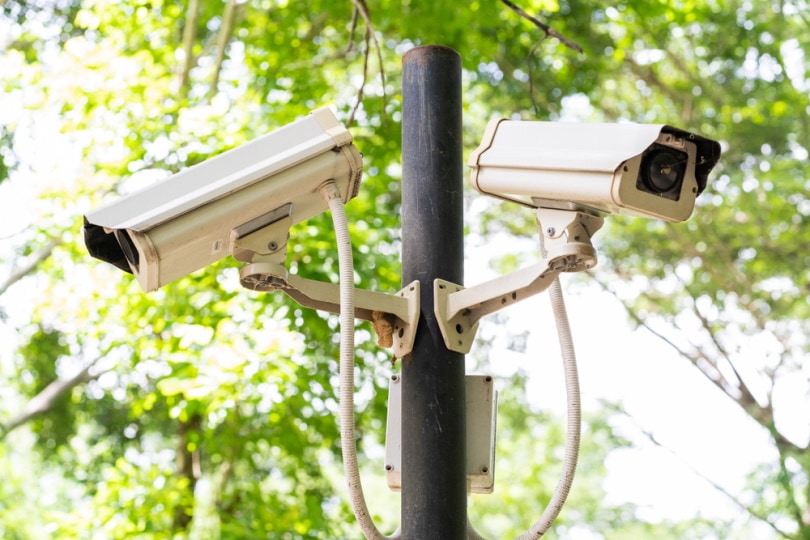
There are many advantages to installing security cameras at your home or workplace. With modern technology, your security camera can send notifications directly to your phone if there are any unexpected visitors.
Aside from giving you peace of mind, security cameras often act as a deterrent for anti-social behavior.
Many of the newer cameras allow for remote viewing, so you can keep an eye on your home no matter where you go.
The type of security camera that will best fit your needs will depend on several factors.
We’ve grouped the different types of security cameras available into several categories, including location, connectivity, shapes, and focal length.

The 12 Types of Security Camera
Security Cameras By Location
While some people choose to point indoor cameras out through their windows, and others may opt to use outdoor cameras inside of buildings, the two types are built differently.
1. Outdoor
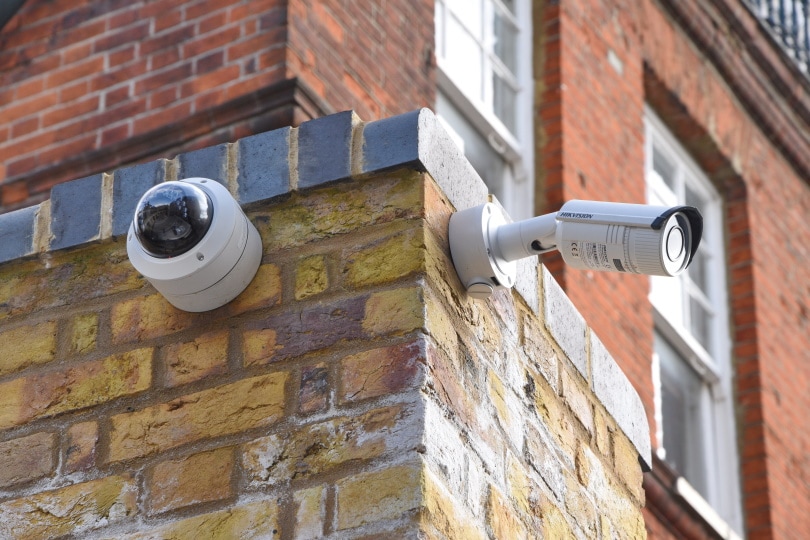
Outdoor cameras are built with strong materials as they are likely to be targeted by both animals and would-be burglars. As such, they are usually heavier and sturdier than indoor cameras and are often priced higher.
In order to operate, outdoor cameras must be weatherproof. They can usually withstand rain, snow, hail, and extreme temperatures.
Outdoor cameras can adjust to changes in lighting conditions throughout the day and night so that they can always capture the best possible footage.
Outdoor cameras usually have movement detection, while most modern cameras also have built-in sirens, lights, and the ability to send notifications.
2. Indoor

When it comes to indoor cameras, style matters. That’s why indoor cameras come in many shapes and sizes and have an overall sleek and seamless look. Indoor cameras are small and can be placed strategically to go almost unnoticed.
Indoor cameras do not need the same level of protection as outdoor cameras, for this reason, they’re usually lighter, and smaller.
Indoor cameras are usually lower priced.

Security Cameras By Connection
When it comes to setting up a security camera, there are four main types of internet connections. There are different advantages to each, and the ideal type will differ depending on factors such as local WiFi and power reliability.
3. Wired
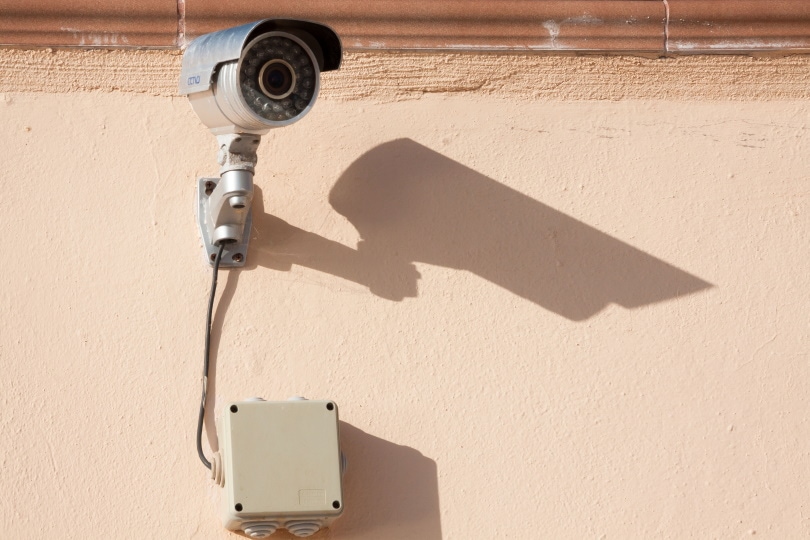
Wired cameras must remain connected to a power source and the internet or DVR box using physical wires. The main advantages of this type of camera are the decreased risk of signal drops from WiFi affecting the footage, and the constant power supply meaning you won’t have to worry about recharging or changing batteries.
- No risk of WiFi signal drops
- No need to recharge batteries
- Wiring makes it difficult to set up
4. Wireless

Not to be confused with wire-free, wireless security cameras still need to be connected to a power source, but they connect to the internet via WiFi. The advantage of a wireless camera over a wired one is that it offers more flexibility on where it can be placed.
- Flexibility on placing
- Vulnerable to signal drops
- Wiring set up for power may be difficult
5. Wire-free

Wire-free cameras have zero cords or wires trailing away from them. They are powered by batteries and connect to the internet via WiFi. This dramatically decreases the hassle of setting one up and makes it possible to install the camera anywhere you wish, without the need to worry about drilling holes or threading cables into the house.
- No wires mean less hassle
- Easy to set up
- Full flexibility in placing
- Vulnerable to signal drops
- Must recharge or change the batteries when needed
6. 3G and 4G-LTE
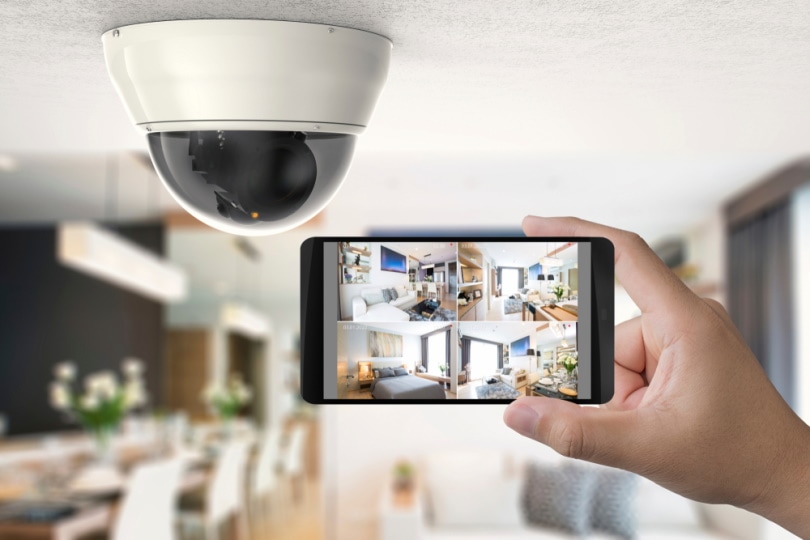
These cameras operate by connecting to the internet over a cellular network. They need a sim to operate, as a phone would. 3G and 4G-LTE security cameras are a good option for homes that have unreliable WiFi, or no internet connection. Most LTE cameras are battery-operated, so they offer the same flexibility as wire-free cameras.
- No risk of WiFi signal drops
- Works without home internet connection
- Ongoing cost due to data plan
- Must recharge or change the batteries when needed

Security Cameras By Shape
The most common shapes that security cameras come in are Bullet, Dome, PTZ, and Turret. They each have their strengths and weaknesses, so let’s take a closer look.
7. Bullet
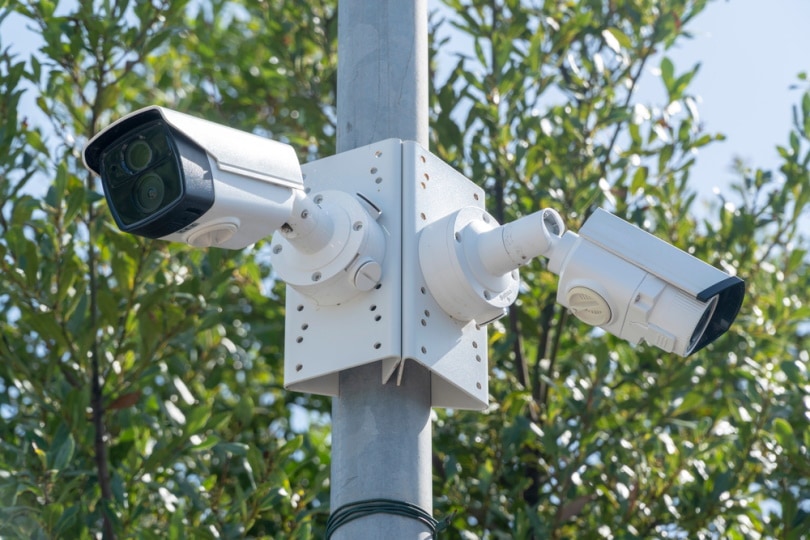
The most common type of home security camera, the Bullet shaped cameras protrude from the wall in an obvious, and eye-catching way. This can be an advantage as they often act as a deterrent.
Although bullet-shaped cameras are built to be sturdy to withstand the chance of vandalism, they’re often mounted high up on buildings, so that they cannot be easily reached.
- Sturdy
- Inexpensive
- Acts as a deterrent
- Unsightly
- Conspicuousness makes it prone to vandalism
8. Pan-tilt-zoom Camera (PTZ)

As the name suggests, the PTZ camera gives remote-controlled pan, tilt, and zoom functionality. These cameras are often used for sporting events and reality television shows where they focus on and follow certain subjects.
- High control over images
- Unsightly
- Expensive
- Prone to malfunctions
9. Dome

Dome cameras are built in such a way as to go unnoticed. They appear as a dark dome, usually stuck to ceilings in banks and other big buildings. Although they offer the same functionality as a bullet camera, dome-shaped security cameras are a good alternative for those who want a discrete option.
The glass dome that encases a dome security camera is usually very strong and protective, however, dust, and dried raindrops, can cause the footage to become unclear over time, especially at night due to IR bounce, which appears as circles that cloud the image.
- Discrete
- Sturdy
- Prone to IR bounce
- The viewing range is limited
10. Turret
https://www.instagram.com/p/CdOhbgTuaX-/
Turret cameras are shaped similarly to dome cameras, but they lack the glass case that dome cameras have, which decreases the risk of dried raindrops and dust interfering with a good picture. This makes turret cameras a better option for placing outdoors, however, the lack of a dome casing makes the turret camera more vulnerable to vandalism.
- Discrete
- Sturdy
- No IR bounce
- More vulnerable to vandalism

Security Cameras By Focal Length
Aside from the shape and connectivity of a camera, depending on the space that needs to be on display, a zoom feature may be necessary.
11. Fixed Lens
https://www.instagram.com/p/Bw2lRsXl6nU/
The focal length cannot be altered on cameras with a fixed lens. These cameras tend to have a wide viewing angle, which means that the picture will cover a large area, but since the focal length cannot be altered, they do not have a zoom function.
12. Varifocal
https://www.instagram.com/p/CIJMhSsHyMG/
Unlike security cameras with a fixed lens, the focal length of varifocal cameras can be adjusted, which can be an advantage if you ever need to zoom in on a detail.
Varifocal cameras are a must if you cannot mount the camera close to the area that you are trying to monitor. For example, when trying to capture footage from a gate or entryway that is 50 feet or farther from your camera.

Conclusion
Modern security cameras come in various shapes and sizes, with endless features and functions. With today’s technology, an LTE camera can be used to send notifications to your phone, even if you don’t have an internet connection at home, while wire-free cameras make the process of setting up a security camera system painless and quick.
With so many options available, setting up a security camera at home doesn’t have to be costly, either. There’s something out there to suit every budget and need.
Featured Image credit: Business stock, Shutterstock
About the Author Cheryl Regan
Cheryl is a freelance content and copywriter from the United Kingdom. Her interests include hiking and amateur astronomy but focuses her writing on gardening and photography. If she isn't writing she can be found curled up with a coffee and her pet cat.
Related Articles:
Monocular vs Telescope: Differences Explained (With Pictures)
How to Clean a Refractor Telescope: Step-by-Step Guide
How to Clean a Telescope Eyepiece: Step-by-Step Guide
How to Clean a Rifle Scope: 8 Expert Tips
What Is a Monocular Used For? 8 Common Functions
How to Clean a Telescope Mirror: 8 Expert Tips
Brightfield vs Phase Contrast Microscopy: The Differences Explained
SkyCamHD Drone Review: Pros, Cons, FAQ, & Verdict
